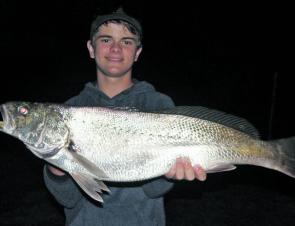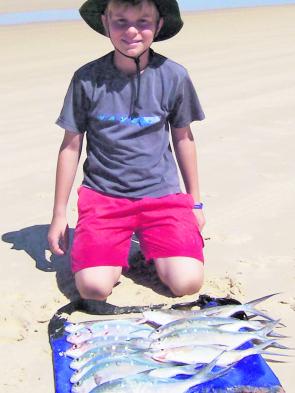Conditions have showed signs of returning to normality after years of heavy rainfall and unkind winds and seas. Finally we can look forward to some rewards for the patience that we have had to bear.
Seven species of sport and recreational fish are to be expected along Fraser Island’s beaches and headlands: dart, whiting, mulloway, flathead, tailor, bream, and tarwine, plus there are as many again that are occasional but welcome catches. There are also many others that are taken in the creeks and mangrove fringes along the Fraser’s western coast between Moon Point and the southern extremity of the island.
By far the most abundant of the popular seven species is the dart or southern swallowtail. They are likely to be prolific right along the eastern beach, and to a lesser extent along the western coast. They show a preference for slight to moderate sea conditions when water clarity is good.
During daylight hours, dart are likely to be in the first line of breakers, or in well developed gutters, particularly under the white water along their edges. At night, however, they like to come into the shallowest water to feed. Although they are likely to be active throughout the tide cycle, the late flood tide is probably the most productive. Indian Head and Waddy Point are handy vantage points to target dart and other species.
There can be little debate when it comes to the best bait for dart. The answer is of course, pipis and sea worms. Pipis may be resident in the beach above the low water mark, in which case they often respond to the pressure of vehicles, moving closer to the surface and forming a smooth or slightly broken bump. They can then be dug by hand or by using a purpose-built piece of PVC pipe, cut at an angle.
The bag limit for pipis in Queensland is 50 per person in possession. Once collected they should be cared for by being kept out of the sun in containers of sea water that is changed regularly. A sickly sight, seen only too often on the island, is of buckets of rotten pipis dumped on the beach. They are number one for dart and for most of the other six popular species. Their only disadvantage is that, being soft baits, they are easily removed by unwanted small fish.
Sea worms are a close second, particularly if pipis are hard to find. It is worthwhile having the skill to catch a few worms. I must admit to seeing very few anglers using artificials for dart. I have persevered with a few with only limited success. The only one that has turned on some interest has been a tiny lime green curly-tail grub.
If there is a down side to dart, it is that their juveniles can be in plague proportions right along the beach, even in the very shallow water. They can make it difficult for whiting anglers working the low water gutters. We shouldn’t complain, at least we know that this is one species unlikely to become extinct any time soon.
Dart have a minimum legal length of 30cm and a bag limit of 30. Thanks to the dart’s long tail, the 30cm limit is over generous. Even a fish at this size is hardly worth keeping for the pan. Dart make excellent table fare, particularly if bled on capture, then filleted and skinned.
Whiting have always been right up there in the popularity stakes on Fraser Island. As regular readers would know, the catches along the main ocean beach have been disappointing for the last couple of years, and there have been lots of reasons given. However there have been significant signs that things are looking up.
I have identified six different types of locations that whiting are likely to be taken:
The open ocean beach holds whiting for most of the year but tends to be most productive from March through to November. They like to congregate in the shallow low water gutters where water running over the banks and spits is likely to carry in small crustaceans, worms and shellfish. The blind ends of these gutters are usually most productive.
Coffee rocks along the island’s beaches are often overlooked as places to find whiting. They can be very worthwhile particularly fishing their sandy edges and the sand patches within the rocks. This is a very challenging and enjoyable way to target whiting as the angler is continually on the move predicting and checking out where the fish might be.
The semi-protected waters at the southern end of the island, down stream of the barge landing, experience a short but sharp season of excellent whiting fishing from late August until the end of October. Best results are to be had by selecting a mid-morning high, then working the ebb. These conditions mirror the most favoured conditions at Inskip Point and the southern end of Bribie Island.
The shallow protected gutters just north of Waddy Point usually hold plenty of whiting. Here they tend to be widespread so quite a bit of searching is often needed. The gutters and beaches west of Sandy Cape also fall into this category.
The western beaches of the island continue to provide some reasonable catches, although nowhere near what it was like when there was an equitable sharing of the resource. Although whiting fishing is worthwhile throughout the year, some of the better catches are made between Moon and Coongul creeks during August and September. Full and new moon tides produce enough movement in the water to keep the fish feeding well.
Finally, arguably the island’s only true estuary, Wathumba Creek, is now zoned yellow and, in theory, a recreational fishery only. Over the high tide, whiting tend to be well scattered, so most anglers like to fish the lower half of the tide when fish tend to become more concentrated in the small gutters and drains.
On the ocean beach, pipis and worms are the bait of choice but on the inside beach pipis are not plentiful. With so many yabbie beds in Wathumba and other creeks it is not surprising that these little crustaceans would come to the fore.
So far I have mentioned only the sand whiting. Although not regularly targeted, the diver (or winter) whiting is sometimes taken along the western beach. To the best of my knowledge, golden lined whiting are not caught on the beaches of the island.
As a reminder, in Queensland sand whiting have a minimum size of a miserable 23cm, and a bag limit of 30.
We have had plenty to say about Fraser Island’s tailor season in recent editions. The 2012 season finally wound down in early December when a few good fish were still being taken at Waddy Point and Sandy Cape.
The season started just about on cue in early July. As already reported it was not a record breaker in terms of numbers and quality of fish taken. Tailor are available for most of the year but those taken outside the winter-spring spawning run are usually in the chopper category with many not making the 35cm limit.
During the peak season, they are likely to appear anywhere along the eastern beach and around the headlands. Most tailor are taken using whole WA pilchards on ganged hooks but an increasing number of anglers are casting 65g and 85g metals. The tailor bag limit is 20.
Although grouped together for legal minimum length (25cm) and bag limit (30), bream and tarwhine, despite superficial similarities, are not closely related. Their more significant differences show up on Fraser Island where they display differences in habitat and food preferences.
Tarwhine prefer baits of pipis or worms, although they have been known to take pilchards. Bream on the other hand will eat worms and pipis but usually show a distinct preference for pilchards, either small whites or blues or WA pilchard halves.
Both species are likely targets throughout the year although more reliable during the cooler months.
Flathead are more plentiful along Fraser’s ocean beach than you might expect.
Perhaps the generally more turbulent water doesn’t lend itself to conventional fly and bait spinning. However in relatively calm conditions it is worthwhile working the well formed gutters and the edges of coffee rocks.
On the western side of the island where conditions are a little more subdued, the creek mouths, timber and rock structure can be rewarding.
The bag limit of five and the size limit from 40-75cm applies to dusky flathead. Bar-tail and sand flathead do have more generous limits but I have yet to see one of these taken from the beaches of the island.
Mulloway are particularly plentiful along the ocean beach between June and October, very much in line with the tailor season. It is believed that they appear when sea mullet start to move up the beach.
Whether they are travelling fish or almost residents is something we can continue to wonder about. I am inclined to think that they might spend the majority of their time a little offshore over the deeper coffee rock reefs, then move inshore when feeding opportunities are worthwhile. On Fraser’s eastern beach, this happens just after dark and might continue for an hour or so. Outside these hours, including daylight, they remain a fair possibility.
When they are in the mood they don’t seem to be too fussy about what they eat. Conventional tailor gear with ganged pilchards will work but tailor and dart can become problems by destroying bait the moment it hits the water.
Mulloway are very partial to sea worms, in fact worms are a natural food source. A bunch of sea worms is a great bait but if there are any dart about it can be very frustrating. Tailor fillets are probably the most reliable baits if dart and tailor are a nuisance. Certainly this bait will cop a hiding but it is likely to withstand the ravages long enough for a mulloway to find it.
Unfortunately tailor fillet baits are likely to attract any munchies that also like to come in to feed at that time. The last thing you need is to be tied up with a shark.
Recent seasons have seen lots of mulloway taken, particularly along the beach between Eurong and the wreck of Maheno. Unfortunately the majority are not making the 75cm minimum legal length. We have found ourselves spending a lot of time removing hooks, then cradling fish of up to 3kg back to the water, and carefully releasing them. Fortunately there have been enough legal fish around to keep everyone interested and perhaps reach the bag limit of two. To the best of my knowledge, last season’s best fish, caught at Poyungan Rocks, tipped the scales at 20kg.
Next month we will take a look at some of the unusual, perhaps unexpected species that turn up from time to time.
Reads: 2290
Pipis and sea worms are out on their own for most beach species.

Jamie’s fish was the only legal mulloway taken that night after dark.

Dart of this quality are there for everyone to enjoy.




